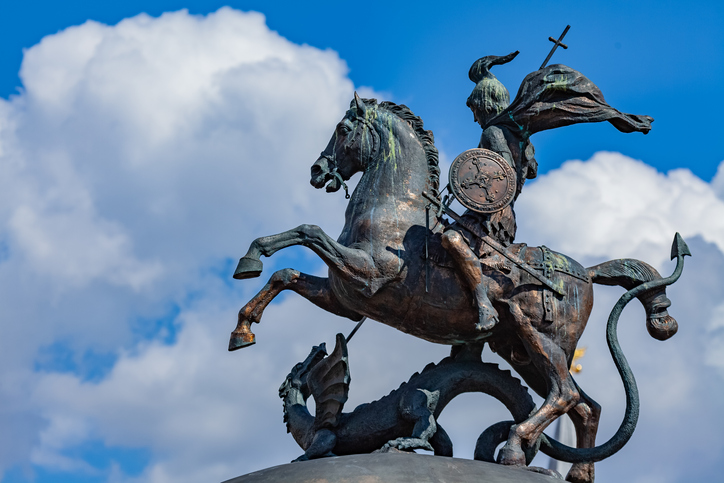Here is where we want to go – a prayer from Singapore, the Church Missionary Society: “God stir the soil, run the plowshare deep, cut the furrows round and round, overturn the hard, dry ground, spare no strength nor toil, even though I weep. In the loose, fresh mangled earth, sow new seed. Free of withered vine and weed, bring fair flowers to birth.”
Let’s pray that prayer.
I concluded last month’s column with a hymn. Then, I met one of our Montana leaders. He told me he loved hymn stories, especially: “O Love that Will Not Let Me Go.” Honoring him – and the marvelous stories behind many hymns – leads to this story.
First, according to legend, St. “George” defeated the dragon and won his lady’s hand while bearing a shield with a red cross.
Our George, George Matheson (1842 – 1906) was born in Glasgow, Scotland – the most overcrowded city in Britain. While George lived there, the middle class began prospering through the labor of people in business as well as industrious engineers and shipbuilders.
Still, poverty dominated this congested city. Despite the best efforts of philanthropists and reformers, Glasgow was a byword for intractable human misery. Age of death averaged 42 for men and 45 for women. On the street, the rich stood out from the poor because the rich were taller. A School Board survey from 1906 revealed that a 14-year-old boy living in a poor area of Glasgow was, on average, 4 inches shorter than such a child from the city’s West End – which had better nutrition and air quality (www.theglasgowstory.com).
During George’s tenth year, his family – an older sister, two younger sisters, and five younger brothers – moved to West End. But, he only dimly saw his new home. Born with poor vision, George’s sight gradually failed until he was nearly blind.
We sometimes take quantum leaps and think that disability in one area of life implies other disabilities. For those of us tempted to misunderstand, George challenges us. George’s academic abilities – and his sisters’ – enlarged his world. Sensing a call to the ministry, George needed to learn Latin, Greek, and Hebrew. His sisters learned those languages to help him study. He graduated from the University of Edinburgh, MA, 1862 – at 20 years of age – The Church of Scotland ordained him. What an achievement!
For 31 years, George kept at this work of ministry – preaching (one congregation numbered 1500+) – leading – pastoring – writing dozens of books. Since he memorized sermons and sections of the Bible, visitors at worship services were often unaware he was blind. George laughed a lot. Having been overtaken by the night, he was confident of the morning. His striking delivery and vibrant voice arrested attention and kept it. Queen Victoria invited him to preach to her and her court.
“George” is Greek – often translated: “farmer.” My grandfathers were farmers. “Farmer” is noble enough for me. But, “George” is more robust, being made from “geo” – “earth” + “erga” (the source of our word “energy”) – “to work.” When you think “George” – think “industrious eco-steward.” On another level, consider George Matheson keeping his hand at the plow – energetically cultivating hearts for the fruitful Gospel seed.
Why do we have such a vast capacity for work? God made us in his image. Jesus declares: “My Father is working until now, and I am working” (Jn 5:17). Jesus loved work – without making it his idol. George demonstrated the Spirit of Christ as he worked.
At some point, George got engaged. However, when his fiancée learned the extent of his blindness, she called off their engagement. She told him she would not go through life with a blind man.
Paul tells us “love” – “agape” – is patient; then, “agape” is kind. Blinded to those insightful truths, we hope his fiancée later came to embrace them.
However, George’s older sister demonstrated the “agape” Paul describes. Year after year, she continued helping George.
However, when George turned 40, a younger sister chose to marry. George felt her loss deeply. As one emotion can give rise to another, his sister’s marriage brought a fresh reminder of his own broken engagement. Amid this severity, Matheson wrote.
“My hymn was composed in the manse, the evening of June 6, 1882, the night of my sister’s marriage. I was alone.” He experienced “most severe mental suffering.” God was plowing his heart.
George began writing: “The hymn was the fruit of that suffering – the quickest bit of work I ever did. I had the impression of having it dictated to me by some inward voice. The whole work was completed in five minutes. It never received any correction. This came like a dayspring from on high.”
“O Love that will not let me go/I rest my weary soul in thee;/I give thee back the life I owe,/That in thine ocean depths its flow/May richer, fuller be.”
“O Light that follows all my way,/I yield my flickering torch to thee;/My heart restores its borrowed ray,/That in thy sunshine’s blaze its day/May brighter, fairer be.”
“O Joy that seeks me through pain,/I cannot close my heart to thee;/I climb the rainbow through the rain,/And feel the promise is not vain,/That morn shall tearless be.”
“O Cross that liftest up my head,/I dare not ask to fly from thee;/I lay in dust life’s glory dead,/And from the ground there blossoms red/Life that shall endless be.”
In George Matheson’s plowed heart, the dayspring from on high revealed adamant enfolding Love, soul-restoring Light, promised tearless Joy, and the Cross – an instrument of torture – that for him, and many others, has become, through Jesus, a reminder of the place where Jesus’ irrevocable love hoisted George and them to eternal life.
Again, according to legend, St. “George” defeated the dragon and won his lady’s hand while bearing a shield with a red cross.
Friend, what deeds of valor await you as you rest in and find vigor through the Cross of Christ?



